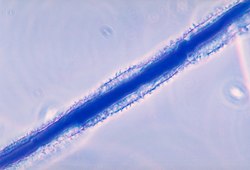Aspergillus flavus
| Aspergillus flavus | |
|---|---|

| |
| Aspergillus flavus | |
| Scientific classification | |
| Kingdom: | |
| Phylum: | |
| Class: | |
| Order: | |
| Family: | |
| Genus: | |
| Species: | A. flavus
|
| Binomial name | |
| Aspergillus flavus | |
Aspergillus flavus is a fungus. It is a common mold in the environment, and can cause storage problems in stored grains. It can also be a human pathogen, associated with aspergillosis of the lungs and sometimes causing corneal, otomycotic, and nasoorbital infections. Many strains produce significant quantities of aflatoxin[1], a carcinogenic and acutely toxic compound. A. flavus spores are allergenic. A. flavus sometimes causes losses in silkworm hatcheries.
Disease in humans
A. flavus is the second most common agent of aspergillosis, the first being Aspergillus fumigatus. A. flavus may invade arteries of the lung or brain and cause infarction. Neutropenia predisposes to aspergillus infection.
Aspergillus flavus also produces a toxin (aflatoxin) which is one of the aetiological agents for hepatocellular carcinoma. [2]
Appearance in culture
A. flavus grows as a yellow-green mold in culture. Like other Aspergillus species it produces a distinctive conidiophore composed of a long stalk supporting an inflated vesicle. Conidiogenous cells on the vesicle produce the conidia. Many strains of A. flavus exhibit a greenish fluorescence under UV light that is correlated with levels of aflatoxin production.
Mold damage
A. flavus is particularly common on corn and peanuts, as well as water damaged carpets, and is one of several species of mold known to produce aflatoxin which can cause acute hepatitis, immunosuppression, and hepatocellular carcinoma. The absence of any regulation of screening for the fungus in countries which also have a high prevalence of viral hepatitis highly increases the risk of hepatocellular carcinoma.
